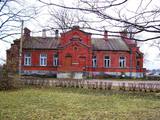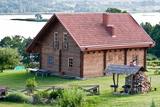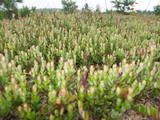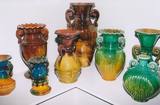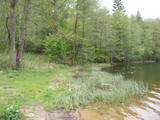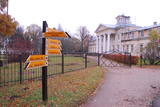| Nr | Name | Beschreibung |
|---|---|---|
|
Das im 18. – 19. Jh entstandene Ensemble von Gutshofsgebäuden mit Museum Audru und Spiritusfabrik. |
||
|
Adamovas Manor (ancient name –Adamhof, Odumova) is the cultural monument of the state importance.
It has two well preserved buildings of the 19th century. The Manor was built in 1851. Landlords
Korfs, Žemčužņikova and Karaulovs were the owners of the manor. There was discovered a mineral spring
in 1905. It was named in the honour of St. Helena. Mineral water gained the highest awards in London in
1912 and in 1913 in Paris. Currently, there is no mineral spring anymore. However, there is Adamova sanatorium
boarding-school for children with psychoneurological illnesses. A modern sports complex was built
in 2006 for organizing national sports competitions. We offer sauna, conference rooms, boat rental, and accommodation
for 120 people.
|
||
|
No Vilces muižas pa pastaigu taku var aiziet līdz pilskalnam (12 m virs apkārtnes, labiekārtots), kas atrodas Vilces un Rukūzes upīšu satekā. Atradumi liecina, ka cilvēku apmetne šeit ir pastāvējusi jau vidējā dzelzs laikmetā. Pilskalna piekājē atrodas atpūtai labiekārtotā Zaķu pļava. Nostāsti vēsta, ka Vilces grava bijusi laupītāja Kaupēna slēpšanās vieta. |
||
|
This is the thickest birch (Betula pendula) tree in Latvia and can be seen from the Klapkalnciems-Milzkalne road.
|
||
|
The cafe is situated in the southern part of Vecpiebalga. The interior decorations are made of oak and boast Latvian symbols, as well as stained glass. Working hours: Monday- Thu 8:00 - 22:00, Fri, Sat 8:00 - 01:00, Sun. 8:00 - 22:00 |
||
|
The hatchery of decorative saplings and their sale (thujas, junipers, meadowsweets, weigelas, barberries, roses, etc.); creating and nurturing a commercial black currant garden, consultations. |
||
|
Atrodas ezera Vilkokšnio ezera krastā - attālā dabas nostūrī, kur smelties spēku un enerģiju. Pirts, guļamistabas ar koka smaržu, vasaras lapene, kamīns, rotaļlaukums, peldēšanās ezerā, makšķerēšana, sporta laukumi, laiva, ūdens velosipēdi, kalnu velosipēdi un kempings. Lauku sētas entnogrāfiskajā istabā tiek cepta mājas maize. Iepazīsieties ar senajiem piederumiem, maizes cepšanas tradīcijām un paražām.
|
||
|
Im Bauernhof werden hochwertige lokale Produkte aus dem Naturpark Dole und selbst angebauten Pflanzen angeboten. Ein Familienunternehmen, das Traditionen schätzt und bewahrt. |
||
|
Das Schloss befindet sich in Krustpils, in der Rīgas Straße 216 b. Die Anfänge des Schlosses sind im Jahr 1237 zu suchen. Damals hat der Bischof von Riga Nikolai aus Magdeburg die Burg von Krustpils gebaut, die die erste befestigte Burg der Kreuzritter in der Region Latgale war. Vom Ende des 16. Jhs. bis zum Anfang des 20. Jhs. gehörte das Schloss dem Ritter Nikolai Korff (und seiner Familie). Das Schloss hat mehrmals unter Kriegen gelitten und ist umgebaut worden, aber trotzdem hat es bis heute seinen eingeschlossenen Hof erhalten, der den mittelalterlichen Burgen charakteristisch war. Mitte des 19. Jhs. bekommt das Schloss die heutige Innenausstattung des Historismus, aber es haben sich auch Elemente der älteren Bebauung erhalten: der Torturm, Hauptwände, Schießluken, Gewölbekonstruktionen, Fensternischen u.a. Während der Sowjetzeit befand sich in dem Schloss die Sowjetarmee, aber neben dem Schloss wurde die sogenannte Kriegsstadt eingerichtet, die heute Pils rajons (der Bezirk des Schlosses) genannt und der von der westlichen Seite von dem Teich Pils dīķis (Teich des Schlosses) eingeschlossen wird. Im Jahr 1994 wurde in dem Schloss das Geschichtsmuseum von Jēkabpils eingerichtet, das man unter der Leitung eines Reiseleiters oder individuell besichtigen kann. Zurzeit ist das Schloss eine der wenigen Sehenswürdigkeiten in Lettland, die man mit Hilfe eines Audio-Reiseführers kennenlernen kann. Von dem Schlossturm bietet sich eine schöne Aussicht. |
||
|
This is not a well known castle hill, but it offers one of the most unusual views of Lake Lielezers of Augstroze. There are ruins on the castle hill, and a short hiking trail has been installed to look at them. This is part of the ZBR.
|
||
|
Eine gut eingerichtete Strecke des Flusses Driksa (ein Nebenarm des Flusses Lielupe) mit einer zweistufigen Promenade, der im Baltikum einzigartigen Brücke Mītava, Aussichtsplätzen, dem Denkmal Student von Jelgava u.a. |
||
|
Atrodas pilsētas centrā - Tirgus laukuma malā. Dievnams tapis 1495. g., pēc Livonijas ordeņa mestra Valtera fon Pletenberga (~ 1450. – 1535.) pavēles. Gadsimtiem ritot, ēka pārbūvēta un tagad redzamais tornis celts 1907. g. Baznīcā apskatāmi nozīmīgi kultūrvēstures pieminekļi: altārglezna “Golgāta” - H. Kīperta darināta kopija (pēc K. Arnoldi Kandavas luterāņu baznīcas oriģināla (1864. g.)), muižniekam Fīlipam Drahenfelsam veltīta epitāfija (B. Bodekers, 16. un 17. gs. mija), A. D. Tīzenhauzenas kapu plāksne (1648. g.), kristāmtrauka pamatne (18. gs.) un piemiņas plāksne 1. pasaules karā un Latvijas Brīvības cīņās kritušajiem draudzes locekļiem (1925. g.). Ap Tirgus laukumu (atjaunots, jauka strūklaka) izvietojies Dobeles vēsturiskais centrs. |
||
|
Bereits 1615 teilte der kurländische Herzog Friedrich Kettler der Stadt Bauska das Privileg für den Bau eines neuen Rathauses zu, was dann im 17.Jh. auch verwirklicht wurde. Der Marktplatz konnte nun stolz das größte Rathaus im ganzen Herzogtum vorweisen. Aus Geldmangel wurde 1852 dessen Turm abgebaut, 1871 das obere Stockwerk. 2011 wurde der Bau des neuen Rathauses endlich abgeschlossen, und Bauska kann nun wieder stolz auf ein neues, hervorragendes Touristik-Objekt sein, das auch von innen besichtigt werden kann. Im erneuerten Rathaus kann man sich in alten Maßeinheiten messen und wiegen lassen, in Ellen und Fuß, in Pud (ein altes russisches Gewichtsmaß, A.d.Ü.) und in Pfund, und dafür eine entsprechende Urkunde erhalten. |
||
|
Neliela apdzīvota un ainaviska vieta plašajā Skrobļa (Skroblus) strauta ielejā. Ciema austrumu pusē atrodas Lietuvas mērogā unikāls objekts – klēts - rija, kur no 1929. g. vietējie cilvēki uzveda un skatījās lauku teātra izrādes. Netālu no tās (uz abiem objektiem ir norādes) atrodas Skrobļa avoti (Skroblaus versmės), kas iztek no dziļas starppauguru ieplakas. Avotu gan ir appludinājis bebru uzceltais dambis. Dienvidos no ciema atrodas vecs grants karjers, kas ir viena no retajām vietām Baltijā, kur dabā ir atrodami krama ieža gabali, kas atnesti ar ledāju. |
||
|
Diese Reise bietet die Möglichkeit, sich mit dem Alltag auf einem modernen Bauernhof vertraut zu machen, der alten Gewerbe- und Arbeitstraditionen anwendet. Alle Produkte, die auf dem Land angebaut werden, sind auf dem Rigaer Zentralmarkt zu finden. Deshalb beginnt die Reise gerade hier - auf einem der größten und ältesten Märkten Europas. Auf dem weiteren Reiseplan stehen der Besuch mehrerer Bauernhöfe und Verkostungen von deren Erzeugnissen - aus natürlichem Saft gemachte Bonbons, Käse, Getreideprodukte, Joghurt, Eis. Ein traditioneller Bauernhof und das Technische Museum Auf jedem Bauernhof gibt es eine kleine Exkursion. Die Reiseroute enthält auch die Besichtigung der vom Architekten Rastrelli entworfenen Perle der Barock- und Rokokoarchitektur - des Schlossmuseums Rundāle mit dessen Park und Rosengarten. Sehenswert in Bauska ist die Ausstellung der historischen Messgerät im Rathaus, das Schloss Bauska und die Bierbrauerei. In Litauen erwarten die Besucher Bauernhöfe, die sich mit Lavendel-, Heilpflanzen- und Hanfanbau beschäftigen und deren Erzeugnisse vor Ort erworben werden können. Die Stadt Anykščiai bietet Reisenden einen Spaziergang auf einer Wanderbrücke oberhalb der Baumwipfel. Die archäologische Stätte Kernavė gehört zum UNESCO-Welterbe. Den Abschluss der Fahrt bilden die im 14.-15. Jahrhundert errichtete Wasserburg Trakai und Vilnius. |
||
|
Das ist ein in Hinblick auf Biotope und Landschaften facettenreiches Territorium. Das Schutzgebiet wurde eingerichtet, um die Nist- und Zugvögel in diesem Gebiet zu schützen. In einem Teil des Sumpfes befindet sich ein Moosbeeren - Bauernhof – einer der ersten künstlich geschaffenen Bauernhöfe dieser Art in Lettland.
|
||
|
This museum is devoted to the career of the ceramist Polikarps Čerņavskis. His work featured light, yellowish and very bright glazing. Guided tours of the museum are available. There are demonstrations of the use of the potter’s wheel. Ceramics can be purchased, and visitors can attend the opening of the kiln. Special works can be commissioned.
|
||
|
Das Museum „Airītes” befindet sich dort, wo der erste Oberste Befehlshaber der Streitkräfte der Republik Lettland Oskars Kalpaks und andere lettische Krieger (u.a. – drei Offiziere) am 6. März 1919 neben der Ortschaft Airītes auf dem Schlachtfeld fielen. Im Jahre 1920 hat man in Airītes durch gesammelte Spenden angefangen, ein Denkmal zu errichten, das am 3. September 1922 eröffnet wurde. 1935 hat man auf Initiative der Gemeinschaft “Das Oberst-Kalpaks-Bataillon” angefangen, ein Gebäude zu bauen, in dem ein Museum zu Ehren der Kämpfe des Kalpaks-Bataillons untergebracht sein müsste. Das Museum wurde ein Jahr später eröffnet. In der Sowjetzeit wurde die Gedenkstätte vernichtet, aber im Gebäude Post und Wohnungen eingerichtet. In der Zeit des Volkserwachens (1988 – 1989) wurde die Gedenkstätte erneuert, aber am 11. November 1990 das Oskars-Kalpaks-Museum neu eröffnet. 2007 verbrannte im Laufe der Renovierungsarbeiten der erste Stock des Gebäudes. Das Museum und die Exposition wurden 2013 erneuert. Die Ausstellungsgegenstände zeigen den Lebensweg von Oskars Kalpaks und die Teilnahme von O. Kalpaks am Lettischen Unabhängigkeitskrieg und Ersten Weltkrieg. Die Museumsarbeiter organisieren regelmäßig Gedenkveranstaltungen und Veranstaltungen zum Lāčplēsis-Tag. |
||
|
Die wichtigste Erscheinung des Waldes von Sasaļi ist der eutrophische See Sasalis, sowie der ungewöhnliche See Melnezers. Von bedeutung sind auch die verschiedenen Waldtypen des Gebietes. Der See Sasalis ist ein beliebter Platz für die Erholung und zum Schwimmen.
|
||
|
Die evangelisch-lutherische Kirche von Krimulda wird als eines der ältesten Gotteshäuser von Lettland angesehen. Die Anfänge der Kirche sind im Anfang des 13. Jhs. gleich nach der Eroberung von Kubesele zu suchen, später wurde die Kirche mehrmals umgebaut. Neben der Kirche ist das Labyrinth für Meditationen Lilijas zieds (Lilienblüte) eingerichtet. Als im Jahr 1217 im Kampf von Viljandi der livische Häuptling Kaupo gefallen ist, wurden seine Aschen laut Erzählungen in der Kirche beigesetzt. Als die Grabstätte von Kaupo wird im Volke ein kleiner Hügel neben dem kleinen Fluss Runtiņupīte (Runtiņš) genannt, an dessen rechten Ufer sich die ungefähr 7 m lange und künstlich gegrabene Höhle Kubeseles ala (Runtiņala) befindet. Am linken Ufer des Flusses Runtiņupīte erhebt sich der Burgberg von Kubesele. An der Kirche beginnt der Naturpfad von Kubesele. Wenn man den Pfad folgt, gelangt man bis zum Fluss Gauja, an dessen Ufer der Stein Lielais (Runtiņa) akmens liegt. Hier kann man auch die von den Flößern von Gauja aufgestellten Ankerklötze besichtigen. Die mittelalterliche Burg von Krimulda (4 km östlich von der Kirche von Krimulda) wurde in der zweiten Hälfte des 13. Jhs. an der Stelle gebaut, wo der Grundufer des Urstromtales von Gauja von dem Tal Vikmestes grava durchgespaltet wird. Die Burg, in der das Domkapitel von Riga – der Rat der Erzbischöfe von Riga – gewirtschaftet hat, war ein eindrucksvolles Gebäude, dessen breiter Innenhof von einer 1,5 m dicken Schutzmauer eingeschlossen war. Im Jahr 1601 hat der schwedische Feldherr Heinrich von Lieven die Burg beim Zurückziehen gesprengt. Heute kann man auf dem von den Wäldern bewachsenen Hügel einige Burgreste besichtigen. Neben den Burgresten befindet sich die Luftseilbahn und beginnt der Serpentinweg von Krimulda. Unweit befindet sich das Landgut von Krimulda, das in den schriftlichen Quellen zum ersten Mal schon im 15. Jh. erwähnt worden ist. Das heutige Schloss des Landgutes wurde im 19. Jh. im Neoklassizismus (der Inhaber – Baron on Lieven) gebaut. In den 1920er Jahren gelang das Schloss nach der Enteignung im Eigentum des Roten Kreuzes, das dort ein Sanatorium für Kinder eingerichtet hat. Heute befindet sich in diesem Schloss das Rehabilitationskrankenhaus Krimulda, aber von den wirtschaftlichen Häusern des Landgutes haben sich die Ställe, das Haus der Diener und der Verwalter und das sogenannte Haus der Schweiz, sowie der Park erhalten. Hier werden thematische Führungen angeboten. Wenn man eine Bootsfahrt auf dem Fluss Gauja unternimmt, kann man in der Nähe die 15 m hohe Steilwand Velnalas klintis (Felsen der Teufelshöhle) besichtigen. Die Steilwand kann man sehr gut auch aus dem anderen – dem linken – Ufer des Flusses Gauja besichtigen, wo ein Picknickplatz eingerichtet ist. In der Mitte der Steilwand befindet sich die ungefähr 19 m tiefe und 4,7 m hohe Höhle Velnala (Teufelshöhle) von Krimulda. Wenn wir von dieser Steilwand das rechte Grundufer des Flusses Gauja Richtung Turaida am unten gehen, können wir die Sandstein-Steilwand von Piķene besichtigen. Unten an der Steilwand ist der ungefähr 1 km lange Biberpfad von Piķene eingerichtet. Am Rande des Pfades befindet sich die 5 m lange Höhle Mazā Velna ala (die kleine Teufelshöhle) mit der Quelle Gudrības avotiņš (Quelle der Weisheit), sowie die genauso lange Höhle Aunapieres ala. Hier kann man auch einige zugewachsene Nebenflüsse sehen. |
||


